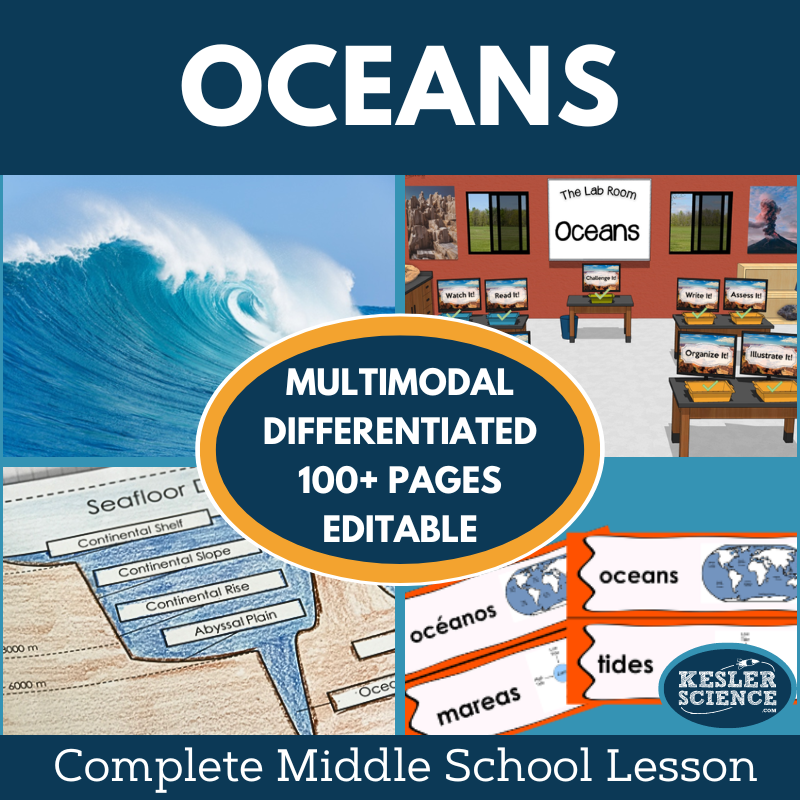
Oceans Complete Lesson Plan - MS
This comprehensive unit provides everything needed to teach middle school students about the oceans. The lesson covers ocean composition, currents, salinity, density, seafloor structures, and the relationship between human activity and marine systems. The resource includes editable presentations, worksheets, student-choice projects, a differentiated station lab, and assessments. Designed for multiday use with minimal prep, it emphasizes student-led, differentiated learning, freeing teachers to focus on facilitating student success.
Essential Questions for Students
-
What elements make up the ocean?
-
How are salinity, temperature, and density connected?
-
How does the sun drive ocean currents?
-
What are examples of seafloor structures, and how are they mapped?
-
How are humans dependent on oceans?
-
How have human activities changed the oceans?
Note for Texas teachers: This lesson aligns with the 2017 TEKS but will not be updated for the 2021 standards.
Key Features
-
Differentiated materials to support a variety of learners
-
Multimodal learning opportunities to maintain engagement
-
Flexible delivery in print and digital formats
-
Editable PowerPoints for easy classroom customization
-
Spanish translations of vocabulary, a station lab reading passage, and interactive notebook pages
Instructional Framework: The 5E Model
This lesson follows the 5E instructional model—Engage, Explore, Explain, Elaborate, Evaluate—ensuring a balance of inquiry, practice, and assessment.
Engage
-
Objectives and Word Wall Cards (English & Spanish)
-
Teacher file with discussion prompts, classroom activity ideas, and misconceptions
Explore
-
A nine-station student-led lab introduces ocean science concepts through multimodal experiences
Input Stations:
-
Explore It! – Hands-on demonstration or experiment
-
Read It! – Differentiated reading passages (English & Spanish) with comprehension questions
-
Research It! – Guided web-based activity with related tasks
-
Watch It! – Short video with reflection questions
Output Stations:
-
Organize It! – Categorization activities with print and digital tools
-
Write It! – Open-ended responses requiring complete sentences
-
Illustrate It! – Sketching and drawing to reinforce learning visually
-
Assess It! – Vocabulary-in-context and mastery-based questions
Bonus Station:
-
Challenge It! – Puzzles, games, and mini-projects for early finishers or enrichment
Explain
-
Editable PowerPoints in standard and interactive versions
-
Interactive Notebook templates (digital & print, English & Spanish)
-
Guided note-taking organizers
Elaborate
-
Student-choice projects on oceans for extension in class or at home
Evaluate
-
Assessments updated for STAAR 2.0, with standard and modified versions
-
Review worksheets and discussion questions for homework, practice, or test prep
Flexible Learning Options
This lesson works seamlessly for in-person or virtual learning. The station lab and interactive notebook templates are fully compatible with PowerPoint and Google Slides, making them easy to integrate into blended or remote classrooms.
This is a finished product; it will be updated with formatting or corrections as needed. Future improvements and new features will be sold as a separate product.
Pickup currently not available
Terms of Use
Copyright © Kesler Science, LLC. All rights reserved by the author. This product is to be used by the original downloader only. Copying for more than one teacher, classroom, department, school, or school system is prohibited. Permission is never granted to enter Kesler Science materials into any form of AI for any purpose. This product may not be distributed or displayed digitally for public view. Failure to comply is
copyright infringement and a violation of the Digital Millennium Copyright Act (DMCA). Clipart and elements found in this PDF are
copyrighted and cannot be extracted and used outside of this file without permission or license. Intended for classroom and personal use ONLY. Multiple licenses are available for purchase by departments,
schools, or school districts. Contact support@keslerscience.com for more information.



















